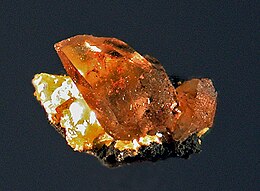
Topaz is a silicate mineral made of aluminum and fluorine with the chemical formula Al2SiO4(F, OH)2. It is used as a gemstone in jewelry and other adornments. Common topaz in its natural state is colorless, though trace element impurities can make it pale blue or golden brown to yellow-orange. Topaz is often treated with heat or radiation to make it a deep blue, reddish-orange, pale green, pink, or purple.

Cinnabar, or cinnabarite, also known as mercurblende is the bright scarlet to brick-red form of mercury(II) sulfide (HgS). It is the most common source ore for refining elemental mercury and is the historic source for the brilliant red or scarlet pigment termed vermilion and associated red mercury pigments.
Briartite is an opaque iron-grey metallic sulfide mineral, Cu2(Zn,Fe)GeS4 with traces of Ga and Sn, found as inclusions in other germanium-gallium-bearing sulfides.

Bornite, also known as peacock ore, is a sulfide mineral with chemical composition Cu5FeS4 that crystallizes in the orthorhombic system (pseudo-cubic).
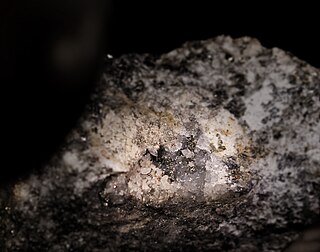
The mineral petzite, Ag3AuTe2, is a soft, steel-gray telluride mineral generally deposited by hydrothermal activity. It forms isometric crystals, and is usually associated with rare tellurium and gold minerals, often with silver, mercury, and copper.

Schreibersite is generally a rare iron nickel phosphide mineral, (Fe,Ni)3P, though common in iron-nickel meteorites. It has been found on Disko Island in Greenland and Illinois.
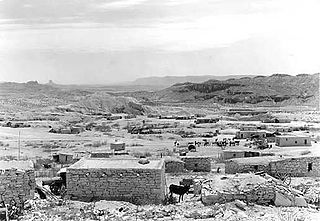
Terlingua is a mining district and census-designated place (CDP) in southwestern Brewster County, Texas, United States. It is located near the Rio Grande and the villages of Lajitas and Study Butte, Texas, as well as the Mexican state of Chihuahua. The discovery of cinnabar, from which the metal mercury is extracted, in the mid-1880s brought miners to the area, creating a city of 2,000 people. The only remnants of the mining days are a ghost town of the Howard Perry-owned Chisos Mining Company and several nearby capped and abandoned mines: the California Hill, the Rainbow, the 248, and the Study Butte mines. The mineral terlinguaite was first found in the vicinity of California Hill.

Stannite is a mineral, a sulfide of copper, iron, and tin, in the category of thiostannates.
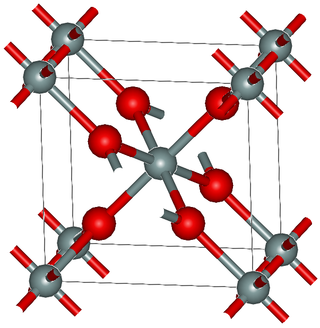
Stishovite is an extremely hard, dense tetragonal form (polymorph) of silicon dioxide. It is very rare on the Earth's surface; however, it may be a predominant form of silicon dioxide in the Earth, especially in the lower mantle.
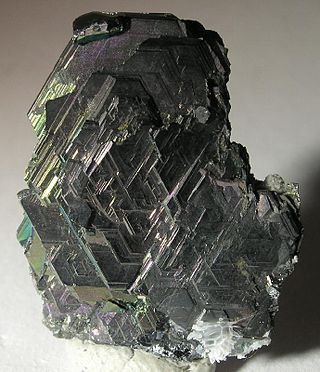
Polybasite is a sulfosalt mineral of silver, copper, antimony and arsenic. Its chemical formula is [(Ag,Cu)6(Sb,As)2S7][Ag9CuS4].

Akaganeite, also written as the deprecated Akaganéite, is a chloride-containing iron(III) oxide-hydroxide mineral, formed by the weathering of pyrrhotite (Fe1−xS).

Arcubisite (Ag6CuBiS4) is a sulfosalt mineral occurring with cryolite in Greenland. It is named after its composition (ARgentum, CUprum, and BISmuth). Its IMA symbol is Acb.
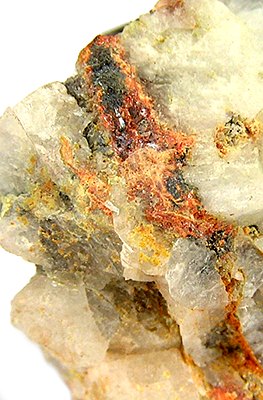
Montroydite is the mineral form of mercury(II) oxide with formula HgO. It is a rare mercury mineral. It was first described for an occurrence in the mercury deposit at Terlingua, Texas and named for Montroyd Sharp who was an owner of the deposit.
Mosesite is a very rare mineral found in few locations. It is a mercury mineral found as an accessory in deposits of mercury, often in conjunction with limestone. It is known to be found in the U.S. states of Texas and Nevada, and the Mexican states of Guerrero and Querétaro. It was named after Professor Alfred J. Moses (1859–1920) for his contributions to the field of mineralogy in discovering several minerals found alongside mosesite. The mineral itself is various shades of yellow and a high occurrence of spinel twinning. It becomes isotropic when heated to 186 °C (367 °F).

Emmonsite, also known as durdenite, is an iron tellurite mineral with the formula: Fe2(TeO3)3·2(H2O). Emmonsite forms triclinic crystals. It is of a yellowish-green color, with a vitreous luster, and a hardness of 5 on the Moh scale.

Pyroxmangite has the general chemical formula of MnSiO3. It is the high-pressure, low-temperature dimorph of rhodonite.
In chemistry, molecular oxohalides (oxyhalides) are a group of chemical compounds in which both oxygen and halogen atoms are attached to another chemical element A in a single molecule. They have the general formula AOmXn, where X is a halogen. Known oxohalides have fluorine (F), chlorine (Cl), bromine (Br), and/or iodine (I) in their molecules. The element A may be a main group element, a transition element, a rare earth element or an actinide. The term oxohalide, or oxyhalide, may also refer to minerals and other crystalline substances with the same overall chemical formula, but having an ionic structure.
Franklinphilite is a phyllosilicate of the stilpnomelane group. Known from only two localities It was found exclusively from the Franklin and Sterling Hill mines in Franklin, Sussex County, New Jersey. until 2013, when a locality in Wales was confirmed

Edoylerite is a rare mercury-containing mineral. Edoylerite was first discovered in 1961 by Edward H. Oyler, whom the mineral is named after, in a meter-sized boulder at the Clear Creek claim in San Benito County, California. The Clear Creek claim is located near the abandoned Clear Creek mercury mine. The material from the boulder underwent several analyses including, X-ray powder diffraction (XRD), a single crystal study, and a preliminary electron microprobe analysis (EMA). Using these analyses it was determined that this was a new mineral but the nature of the material at the time prevented further investigation. It was not until 1986, with the discovery of crystals large enough for a crystal structure determination and a sufficient quantity for a full mineralogical characterization, that the study was renewed. The new edoylerite crystals were found in the same area at the Clear Creek claim but were situated in an outcrop of silica-carbonate rock. This silica-carbonate rock was mineralized by cinnabar following the hydrothermal alteration of the serpentinite in the rock. Edoylerite is a primary alteration product of cinnabar. Though found with cinnabar, the crystals of edoylerite do not typically exceed 0.5mm in length. The ideal chemical formula for edoylerite is Hg32+Cr6+O4S2
Waldemar Theodore Schaller was an American mineralogist and longtime employee of the United States Geological Survey (USGS).
